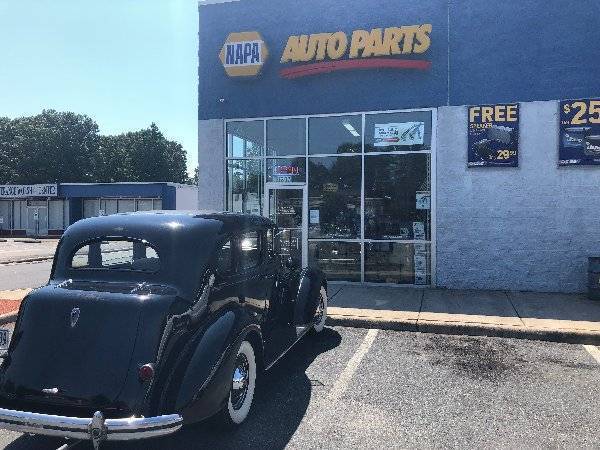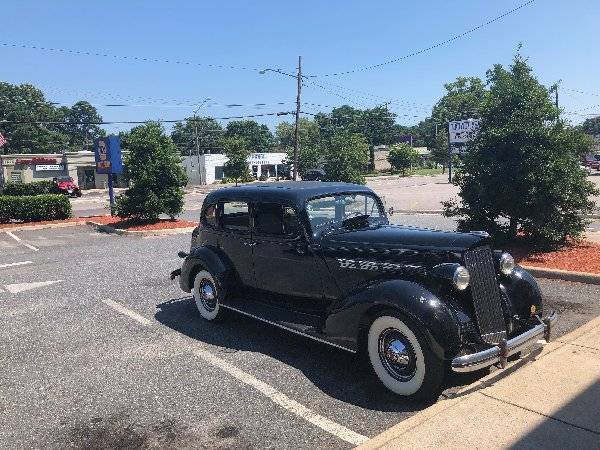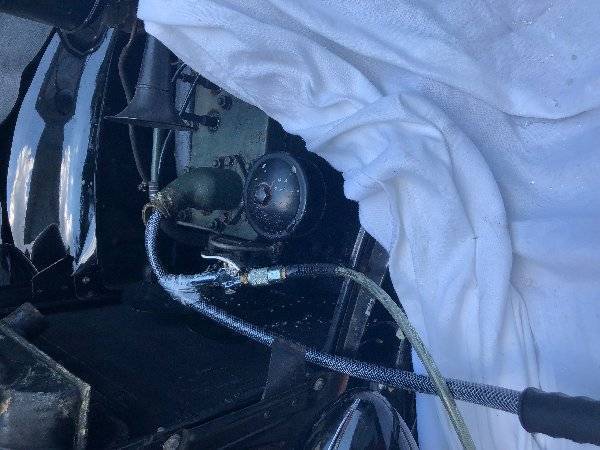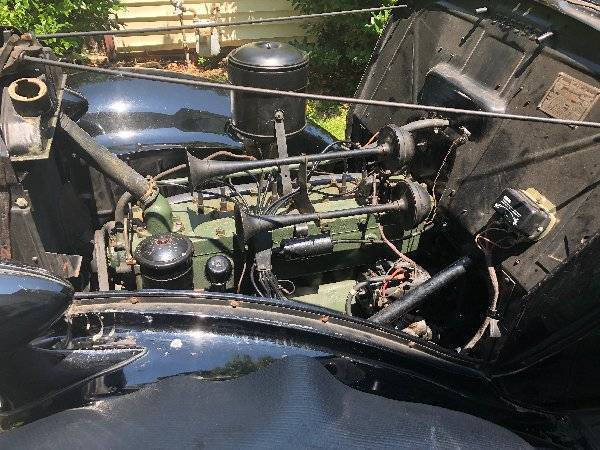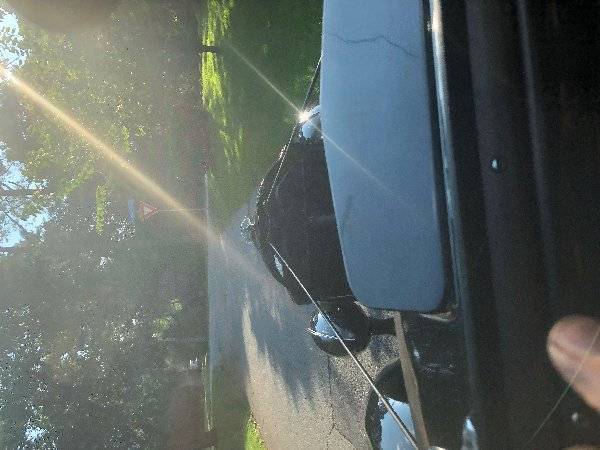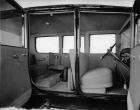|
Re: Ken's 1937 120 Touring Sedan
|
||||
|---|---|---|---|---|
|
Home away from home
|
Most of the details of my running rich saga are posted here:packardinfo.com/xoops/html/modules/newbb ... flat&order=ASC&type=&mode=0&start=0
but I did some general checking today to rule things out. Since wiring the heat riser valve open seems to have made a large difference, and the economizer valve checks out, I'm going to put fresh plugs in, once they get here on Wednesday, and drive it for a while. I verified fuel pump pressure is good - the stock mechanical pump is making 3.75 psi. Maybe a little low, but since I didn't have a tee-fitting, I ran the car off of what was in the float bowl and that was the highest pressure I got. My fuel filter is on the suction side. I think I want to put a glass filter with replaceable element on the discharge side, that way I'm filtering anything that might come off the pump too. I don't want to put the filter up over the manifold area, even though that makes for easier maintenance - it seems too hot. I realized as I was digging through my notes that I never did a compression test. Very happy with the results. With the carb removed (it was off for other reasons, not just for the test!) I had between 130 and 132 psi on all cylinders. I removed the tailpipe today. It ends just under the trunk, and I've never been happy with that. Looking at other pre-war cars, most tailpipes seem to extend just past the bumper. I found a good local shop through my car club, and I'm going to take my current tailpipe to him to make it longer. I have an exhaust leak from two stripped out bolt holes on the intake manifold where it meets the exhaust manifold. I have a new intake manifold, and I'm trying to find a place to get it porcelain coated before I install it. Still making some phone calls. I thought about using Jet Hot like I did on the exhaust, but porcelain was the original spec, and it seems like it would hold up just fine on the intake. I'm open to opinions, if anyone has had more experience here. Trying to get a quote from Prairie Auto Porcelain for now.
Posted on: 2019/7/15 21:14
|
|||
|
1937 120 1092 - Original survivor for driving and continued preservation. Project blog / Registry
1937 115 1082 - Total basket case, partial restoration, sold Hershey 2015 Project blog / Registry |
||||
|
||||
|
Re: Ken's 1937 120 Touring Sedan
|
||||
|---|---|---|---|---|
|
Home away from home
|
Thanks Owen!
On my compression. I was thinking about it last night, and it seems too high. Factory spec is 118 psi for the high compression head. My compression ratio appears to be about 7.8:1, vs 7.0:1. This explains a few things. It seems like the car runs a bit hot, especially under load, and I thought I've heard light pinging a few times while pulling a hill, especially if lugging the engine a little bit. Factory timing for the HC head is 4 degrees BTDC. I think I may try to retard it a degree or too and see how it runs. Any thoughts?
Posted on: 2019/7/16 17:03
|
|||
|
1937 120 1092 - Original survivor for driving and continued preservation. Project blog / Registry
1937 115 1082 - Total basket case, partial restoration, sold Hershey 2015 Project blog / Registry |
||||
|
||||
|
Re: Ken's 1937 120 Touring Sedan
|
||||
|---|---|---|---|---|
|
Forum Ambassador

|
Retarding the spark a degree or two should alleviate the preignition pinging but could exacerbate the tendency to run warm. My suggestion would be to go to a slightly higher octane gasoline and see if the preignition is eliminated.
Posted on: 2019/7/16 17:21
|
|||
|
||||
|
Re: Ken's 1937 120 Touring Sedan
|
||||
|---|---|---|---|---|
|
Home away from home
|
Owen, thanks. I'll give that a shot after I run through this tank.
I'm suprised at how high the compression ratio is. Whoever rebuilt the engine must have taken quite a bit off of the HC head to get the ratio up. New plugs didn't come until after 9 last night, and my new tailpipe won't be done until today, so if the rain holds off today, I should be able to tell if it is going to smoke less. Do these cars smoke a little bit even when properly tuned, or and I correct in thinking they should be pretty much smoke free if properly tuned up?
Posted on: 2019/7/18 7:52
|
|||
|
1937 120 1092 - Original survivor for driving and continued preservation. Project blog / Registry
1937 115 1082 - Total basket case, partial restoration, sold Hershey 2015 Project blog / Registry |
||||
|
||||
|
Re: Ken's 1937 120 Touring Sedan
|
||||
|---|---|---|---|---|
|
Forum Ambassador

|
One might expect to see some "black" smoke or carbon from incomplete combustion when the choke is less than fully open but once fully warmed I would not expect to see it under normal driving conditions.
Posted on: 2019/7/18 8:56
|
|||
|
||||
|
Re: Ken's 1937 120 Touring Sedan
|
||||
|---|---|---|---|---|
|
Home away from home
|
Moving ahead. With a fresh set of plugs and the heat riser valve open, it doesn't smoke.
New tailpipe installed. Still running hot - halfway between 180 and 212 on the gauge. Thermometer on the head reads 210-215, radiator seems to read about 190 to 160. I'm going to check the thermostat, flush with oxalic (spelling?) acid, and then progress. Belt, hoses, etc, check out. I may check the water pump before I flush, may do it after.
Posted on: 2019/7/18 17:14
|
|||
|
1937 120 1092 - Original survivor for driving and continued preservation. Project blog / Registry
1937 115 1082 - Total basket case, partial restoration, sold Hershey 2015 Project blog / Registry |
||||
|
||||
|
Re: Ken's 1937 120 Touring Sedan
|
||||
|---|---|---|---|---|
|
Home away from home
|
Completed some maintenance on my cooling system this weekend. Removed the thermostat and performed an oxalic acid flush with 12 oz of oxalic acid. Drove for about 40 minutes, including a parts run.
Once the car cooled off, I removed the hood and built a homemade flushing gun. It worked well. I didn't see a lot of crud in my geysers, but quite a bit of color came out with the initial drain following the flush. One interesting note - I've had the car for four years, and this is the first time I had the hood off. I don't have a front hood retainer! Never noticed until I took the hood off. Installed new upper and lower radiator hoses and a modern, pellet-type 160 degree thermostat. The initial test drive (hoodless) went great, and I seemed to drop 15-20 degrees across the cylinder head. Drove to a friend's house, with the whole family (and hood back on!) and she ran just a nudge above 180 the whole way. The drive was in the mid-afternoon with a heat index of 117 and lots of idling at traffic lots. Very pleased. On the way home, nearly the same conditions, except had the headlights on. Once I confirm no leaks today, I'll drain the straight water that is in it and return to 50/50 anti-freeze. I purchased the Napa brand that is "safe for all years" so I'm assuming it contains OADs, vice IADs. The parts man thought the same. Next step is to send off the new intake manifold so I can ultimately fix an exhaust leak, service the steering box, and inspect/fill the shocks. It also is not running quite as smooth as I think it should be able to (slight lope or miss), so I'll try and track that down. All in all a good weekend. One question for the crowd - has anyone had luck replacing the front motor mount rubber with the front clip on? Seems a bit tight.
Posted on: 2019/7/22 9:19
|
|||
|
1937 120 1092 - Original survivor for driving and continued preservation. Project blog / Registry
1937 115 1082 - Total basket case, partial restoration, sold Hershey 2015 Project blog / Registry |
||||
|
||||
|
Re: Ken's 1937 120 Touring Sedan
|
||||
|---|---|---|---|---|
|
Home away from home
|
Quote:
Higher than normal compression test results may be the sign of an accumulation of carbon in the combustion chambers and tops of the pistons. This condition will also lead to pre-ignition as the carbon continues to stay hot. JWL
Posted on: 2019/7/22 11:10
|
|||
|
We move toward
And make happen What occupies our mind... (W. Scherer) |
||||
|
||||
|
Re: Ken's 1937 120 Touring Sedan
|
||||
|---|---|---|---|---|
|
Home away from home
|
Quote:
Thanks JW! I hadn't thought of that. Maybe I'll use 89 octane fuel and a quart of diesel the next time I fuel up to see if I can clean it out. The engine has supposedly been rebuilt, but it didn't come with any documentation, so who knows.
Posted on: 2019/7/22 11:23
|
|||
|
1937 120 1092 - Original survivor for driving and continued preservation. Project blog / Registry
1937 115 1082 - Total basket case, partial restoration, sold Hershey 2015 Project blog / Registry |
||||
|
||||

 (288.91 KB)
(288.91 KB)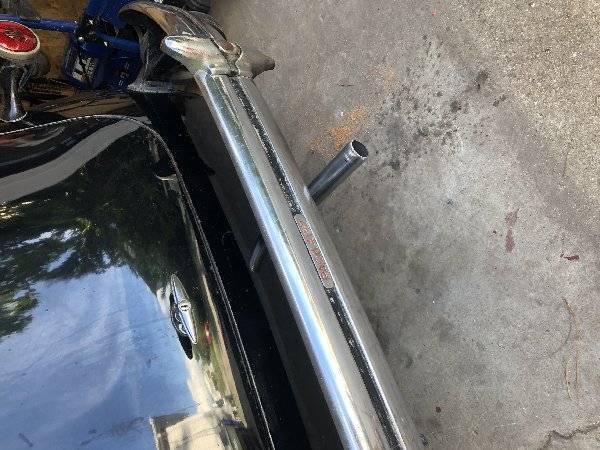

 (341.69 KB)
(341.69 KB)